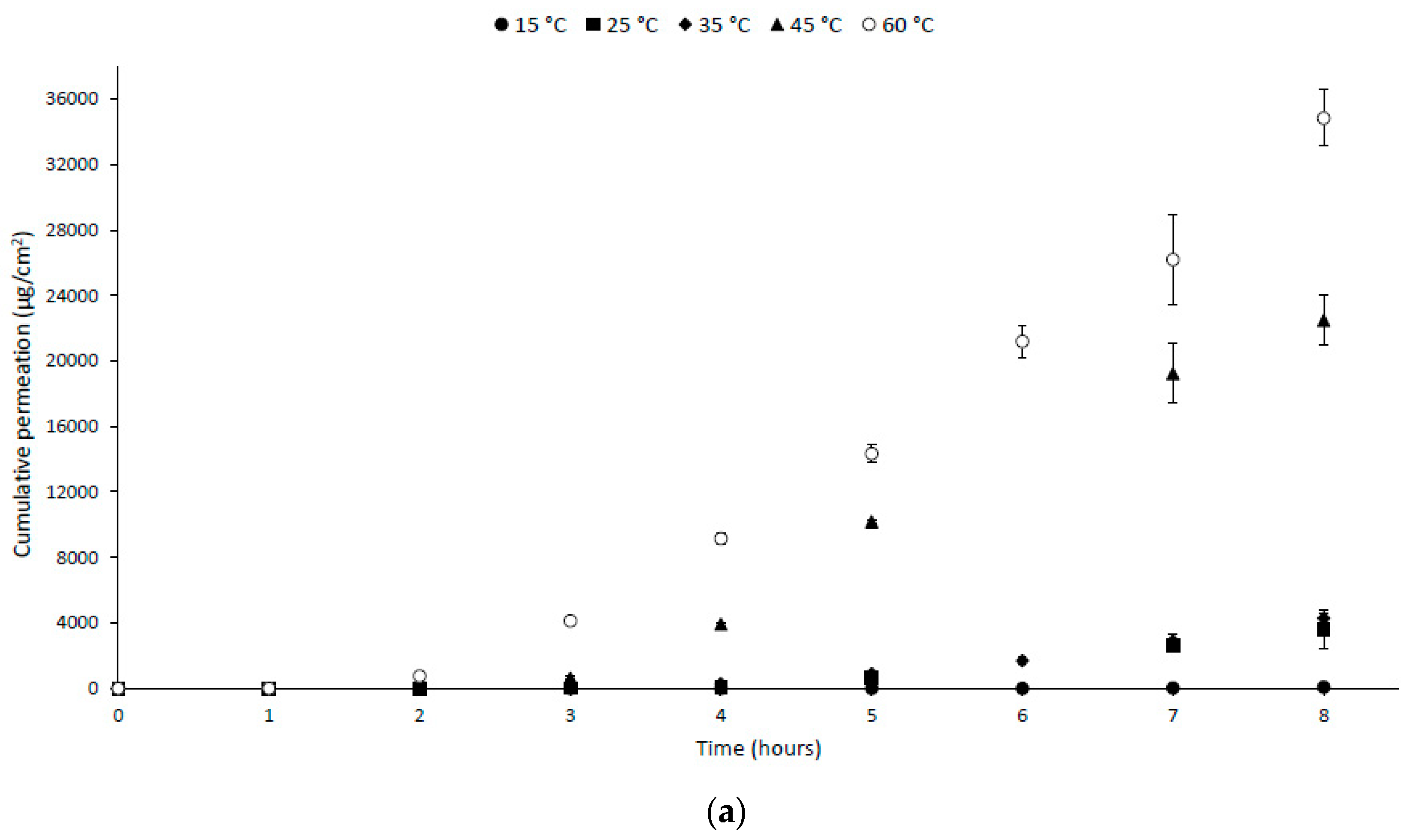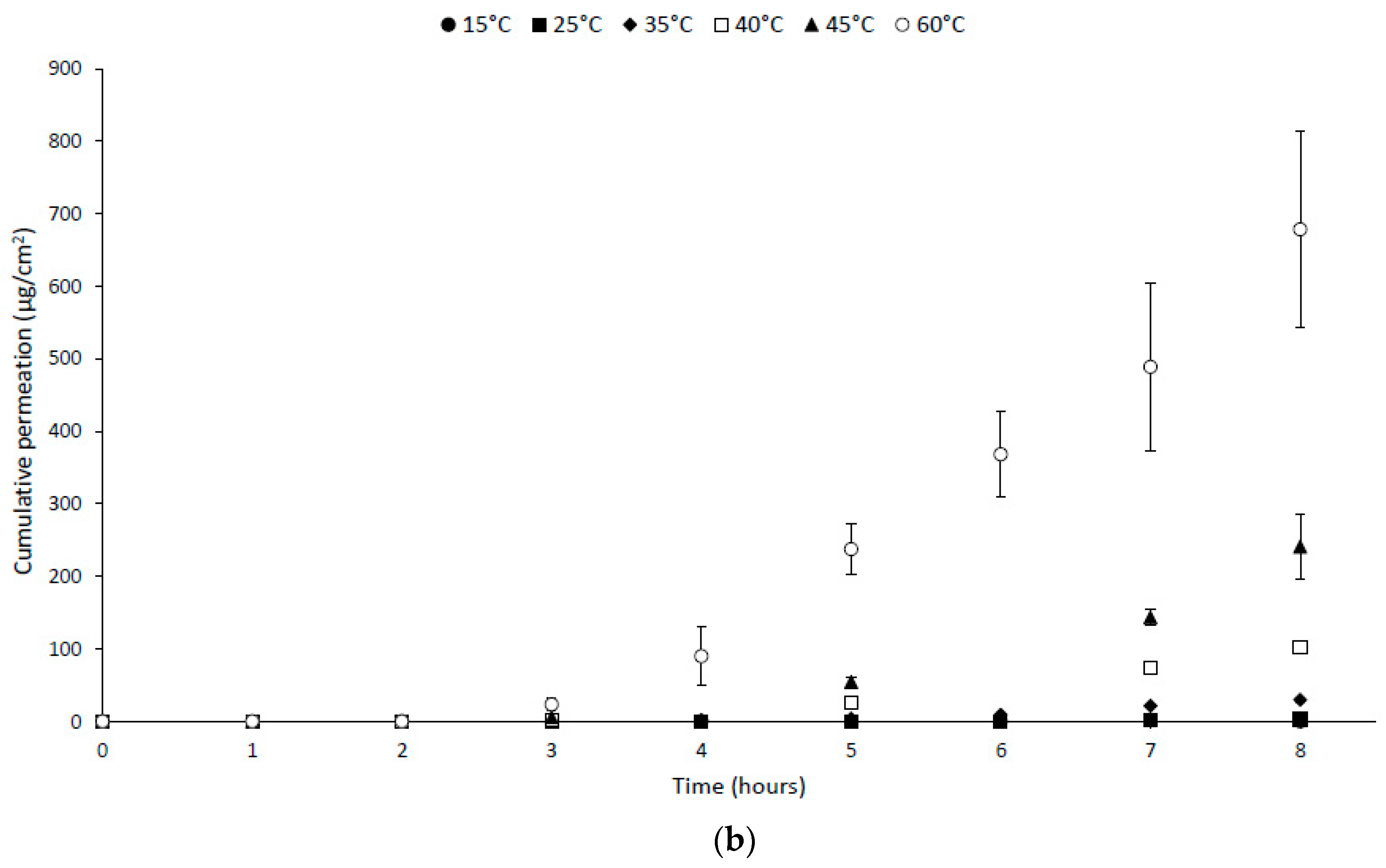Exposure of Agriculture Workers to Pesticides: The Effect of Heat on Protective Glove Performance and Skin Exposure to Dichlorvos
Abstract
:1. Introduction
2. Materials and Methods
2.1. Overall Approach
2.2. Materials
2.3. Glove Performance Tests
2.4. Skin Permeation Tests
2.5. Temperature Studies
2.6. Dichlorvos Quantification
2.7. Data Treatment and Statistics
3. Results
3.1. Glove Performance Studies
3.2. Skin Permeation Studies
4. Discussion
5. Conclusions
Author Contributions
Funding
Acknowledgments
Conflicts of Interest
References
- ATSDR. Toxicological Profile for Dichlorvos; US Department of Health and Human Services, Public Health Service, Agency for Toxic Substances and Disease Registry: Atlanta, GA, USA, 1997.
- APVMA. Dichlorvos Final Review Report and Regulatory Decision; Australian Pesticides and Vetinary Medicines Authority: Kingston, Australia, 2011.
- Okoroiwu, H.U.; Iwara, I.A. Dichlorvos toxicity: A public health perspective. Interdiscip. Toxicol. 2018, 11, 129–137. [Google Scholar] [CrossRef] [PubMed]
- Srinivas Rao, C.H.; Venkateswarlu, V.; Surender, T.; Eddleston, M.; Buckley, N.A. Pesticide poisoning in south india: Opportunities for prevention and improved medical management. Trop. Med. Int. Health 2005, 10, 581–588. [Google Scholar] [CrossRef] [PubMed]
- Ye, M.; Beach, J.; Martin, W.J.; Senthilselvan, A. Occupational pesticide exposures and respiratory health. Int. J. Environ. Res. Public Health 2013, 10, 6442–6471. [Google Scholar] [CrossRef] [PubMed]
- Dowling, K.C.; Seiber, J.N. Importance of respiratory exposure to pesticides among agricultural populations. Int. J. Toxicol. 2002, 21, 371–381. [Google Scholar] [CrossRef]
- MacFarlane, E.; Carey, R.; Keegel, T.; El-Zaemay, S.; Fritschi, L. Dermal exposure associated with occupational end use of pesticides and the role of protective measures. Saf. Health Work 2013, 4, 136–141. [Google Scholar] [CrossRef]
- Lander, F.; Hinke, K. Indoor application of anti-cholinesterase agents and the influence of personal protection on uptake. Arch. Environ. Contam. Toxicol. 1992, 22, 163–166. [Google Scholar] [CrossRef]
- Coffman, C.W.; Stone, J.F.; Slocum, A.C.; Landers, A.J.; Schwab, C.V.; Olsen, L.G.; Lee, S. Use of engineering controls and personal protective equipment by certified pesticide applicators. J. Agric. Saf. Health 2009, 15, 311–326. [Google Scholar] [CrossRef]
- Fenske, R.A.; Birnbaum, S.G.; Methner, M.M.; Lu, C.; Nigg, H.N. Fluorescent tracer evaluation of chemical protective clothing during pesticide applications in central florida citrus groves. J. Agric. Saf. Health 2002, 8, 319–331. [Google Scholar] [CrossRef]
- Aprea, C.; Terenzoni, B.; De Angelis, V.; Sciarra, G.; Lunghini, L.; Borzacchi, G.; Vasconi, D.; Fani, D.; Quercia, A.; Salvan, A.; et al. Evaluation of skin and respiratory doses and urinary excretion of alkylphosphates in workers exposed to dimethoate during treatment of olive trees. Arch. Environ. Contam. Toxicol. 2005, 48, 127–134. [Google Scholar] [CrossRef] [PubMed]
- Krzemińska, S.; Szczecińska, K. Proposal for a method for testing resistance of clothing and gloves to penetration by pesticides. Ann. Agric. Environ. Med. 2001, 8, 145–150. [Google Scholar] [PubMed]
- Moore, C.A.; Wilkinson, S.C.; Blain, P.G.; Dunn, M.; Aust, G.A.; Williams, F.M. Use of a human skin in vitro model to investigate the influence of ‘every-day’ clothing and skin surface decontamination on the percutaneous penetration of organophosphates. Toxicol. Lett. 2014, 229, 257–264. [Google Scholar] [CrossRef] [PubMed]
- Gold, R.E.; Holcslaw, T.; Tupy, D.; Ballard, J.B. Dermal and respiratory exposure to applicators and occupants of residences treated with dichlorvos (ddvp). J. Econ. Entomol. 1984, 77, 430–436. [Google Scholar] [CrossRef] [PubMed]
- Perger, G.; Kruger, E.; Krausse, T.; Schilling, U. Measurements of the exposure to dichlorvos (ddvp) and biological monitoring of users. Zent. Arb. Arb. Prophyl. Ergon. 1991, 41, 7–11. (In German) [Google Scholar]
- Moore, C.A.; Wilkinson, S.C.; Blain, P.G.; Dunn, M.; Aust, G.A.; Williams, F.M. Percutaneous absorption and distribution of organophosphates (chlorpyrifos and dichlorvos) following dermal exposure and decontamination scenarios using in vitro human skin model. Toxicol. Lett. 2014, 229, 66–72. [Google Scholar] [CrossRef]
- Mineau, P. A comprehensive re-analysis of pesticide dermal toxicity data in birds and comparison with the rat. Environ. Toxicol. Pharmacol. 2012, 34, 416–427. [Google Scholar] [CrossRef] [PubMed]
- Luty, S.; Latuszynska, J.; Halliop, J.; Tochman, A.; Obuchowska, D.; Przylepa, E.; Korczak, E.; Bychawski, E. Toxicity of dermally absorbed dichlorvos in rats. Ann. Agric. Environ. Med. 1998, 5, 57–64. [Google Scholar] [PubMed]
- Ali, F.A.; Abdalla, M.H. Pathological changes in testes and liver of male albino rats after dermal exposure to ddvp insecticide. J. Egypt Public Health Assoc. 1992, 67, 565–578. [Google Scholar]
- Dikshith, T.S.S.; Datta, K.K.; Chandra, P. 90 day dermal toxicity of ddvp in male rats. Bull. Environ. Contam. Toxicol. 1976, 15, 574–580. [Google Scholar] [CrossRef]
- Caserta, F.; Wood, D.G.; Brown, M.B.; McAuley, W.J. The effect of heat on diclofenac permeation through human skin. In Advances in Dermatological Sciences; The Royal Society of Chemistry: Cambridge, UK, 2014; pp. 157–168. [Google Scholar]
- Prodduturi, S.; Sadrieh, N.; Wokovich, A.M.; Doub, W.H.; Westenberger, B.J.; Buhse, L. Transdermal delivery of fentanyl from matrix and reservoir systems: Effect of heat and compromised skin. J. Pharm. Sci. 2010, 99, 2357–2366. [Google Scholar] [CrossRef]
- Akomeah, F.; Nazir, T.; Martin, G.P.; Brown, M.B. Effect of heat on the percutaneous absorption and skin retention of three model penetrants. Eur. J. Pharm. Sci. 2004, 21, 337–345. [Google Scholar] [CrossRef]
- David Grays DDVP 500 Insecticide Material Safety Data Sheet. David Gray & Co Pty Ltd.: Western Australia, Australia, 21 June 2010. Available online: davidgray.com.au/storage/file-msds-list/MSDS%20DDVP%20500.pdf (accessed on 26 June 2019).
- Guidance document for the conduct of skin absorption studies. In Proceedings of the Joint Meeting of the Chemicals Committee and the Working Party on Chemicals, Pesticides and Biotechnology, Paris, France, 5 March 2004.
- Lawrence, J.N. Electrical resistance and tritiated water permeability as indicators of barrier integrity of in vitro human skin. Toxicol. In Vitro 1997, 11, 241–249. [Google Scholar] [CrossRef]
- Diembeck, W.; Beck, H.; Benech-Kieffer, F.; Courtellemont, P.; Dupuis, J.; Lovell, W.; Paye, M.; Spengler, J.; Steiling, W. Test guidelines for in vitro assessment of dermal absorption and percutaneous penetration of cosmetic ingredients. Food Chem. Toxicol. 1999, 37, 191–205. [Google Scholar] [CrossRef]
- Davies, D.J.; Ward, R.J.; Heylings, J.R. Multi-species assessment of electrical resistance as a skin integrity marker for in vitro percutaneous absorption studies. Toxicol. In Vitro 2004, 18, 351–358. [Google Scholar] [CrossRef] [PubMed]
- Heath, L.; Gaskin, S.; Pisaniello, D.; Crea, J.; Logan, M.; Baxter, C. Skin absorption of ethylene oxide gas following exposures relevant to hazmat incidents. Ann. Work Expo. Health 2017, 61, 589–595. [Google Scholar] [CrossRef] [PubMed]
- Aust/NZ Standard. Part 10.3: Protective gloves against chemicals and micro-organisms, determination of resistance to permeation by chemicals. In 2161 Occupational Protective Gloves; Standards Australia/Standard New Zealand: Sydney, Australia, 2005. [Google Scholar]
- Ismail, I. Occupational Exposure to Organophosphorus Pesticides: Exploratory Case Studies of Factors Influencing Glove Performance and Skin Penetration. Ph.D. Thesis, University of Adelaide, Adelaide, Australia, 2016. [Google Scholar]
- Ismail, I.; Pisaniello, D.; Gaskin, S.; Edwards, J.W. Dermal exposures to organophosphorus pesticides for ambulance workers—Permeation through disposable gloves: Findings for omethoate. J. Health Saf. Res. Pract. 2015, 7, 14–22. [Google Scholar]
- Blank, I.H.; Scheuplein, R.J.; Macfarlane, D.J. Mechanism of percutaneous absorption: Iii. The effect of temperature on the transport of non-electrolytes across the skin. J. Investig. Dermatol. 1967, 49, 582–589. [Google Scholar] [CrossRef] [PubMed]
- Canning, K.; Jablonski, W.; McQuillan, P. Quantification of surface defects on chemically protective gloves following their use in agriculture. Ann. Agric. Environ. Med. 1998, 5, 45–56. [Google Scholar]
- Rawson, B.V.; Cocker, J.; Evans, P.G.; Wheeler, J.P.; Akrill, P.M. Internal contamination of gloves: Routes and consequences. Ann. Work Expo. Health 2005, 49, 535–541. [Google Scholar]
- Nielsen, J.B.; Sørensen, J.A. Glove material, reservoir formation, and dose affect glove permeation and subsequent skin penetration. Sci. Total Environ. 2012, 417, 87–91. [Google Scholar] [CrossRef]
- Tibaldi, R.; ten Berge, W.; Drolet, D. Dermal absorption of chemicals: Estimation by IH SkinPerm. J. Occup. Environ. Hyg. 2014, 11, 19–31. [Google Scholar] [CrossRef]


| Temperature (°C) | Breakthrough Time 1 (hours) | Maximum Permeation Rate (µg/cm2/min) | |
|---|---|---|---|
| Concentrate | 15 | >8 | 0.86 (±0.33) |
| 25 | 4 | 14.1 (±1.1) | |
| 35 | 4 | 22.4 (±3.5) | |
| 45 | 3 | 102 (±0.3) | |
| 60 | 2 | 137 (±60) | |
| Application Strength | 15 | >8 | <LOD |
| 25 | >8 | 0.0188 (±0.005) | |
| 35 | >8 | 0.196 (±0.03) | |
| 40 | >8 | 0.476 (±0.13) | |
| 45 | 8 | 1.73 (±0.38) | |
| 60 | 3 | 3.02 (±1.0) |
| ΔEa 15–45 °C (kJ/mol) | ΔEa 25–60 °C (kJ/mol) | |
|---|---|---|
| Concentrate | 45.0 (R2 = 0.88) | 20.1 (R2 = 0.92) |
| Temperature (°C) | Jss (µg/cm2/h) | Kp (10−4 cm/h) | Lag Time (h) | |
|---|---|---|---|---|
| Concentrate | 25 | 30.4 (±1.1) | 0.217 (±0.008) | 2.2 |
| 37 | 277 (±0.03) | 1.52 (±0.0002) | 1.8 | |
| Application Strength | 25 | ND | ND | ND |
| 37 | 15.0 (±0.6) | 25.0 (±0.98) | 0.38 |
© 2019 by the authors. Licensee MDPI, Basel, Switzerland. This article is an open access article distributed under the terms and conditions of the Creative Commons Attribution (CC BY) license (http://creativecommons.org/licenses/by/4.0/).
Share and Cite
Thredgold, L.; Gaskin, S.; Quy, C.; Pisaniello, D. Exposure of Agriculture Workers to Pesticides: The Effect of Heat on Protective Glove Performance and Skin Exposure to Dichlorvos. Int. J. Environ. Res. Public Health 2019, 16, 4798. https://doi.org/10.3390/ijerph16234798
Thredgold L, Gaskin S, Quy C, Pisaniello D. Exposure of Agriculture Workers to Pesticides: The Effect of Heat on Protective Glove Performance and Skin Exposure to Dichlorvos. International Journal of Environmental Research and Public Health. 2019; 16(23):4798. https://doi.org/10.3390/ijerph16234798
Chicago/Turabian StyleThredgold, Leigh, Sharyn Gaskin, Chloe Quy, and Dino Pisaniello. 2019. "Exposure of Agriculture Workers to Pesticides: The Effect of Heat on Protective Glove Performance and Skin Exposure to Dichlorvos" International Journal of Environmental Research and Public Health 16, no. 23: 4798. https://doi.org/10.3390/ijerph16234798
APA StyleThredgold, L., Gaskin, S., Quy, C., & Pisaniello, D. (2019). Exposure of Agriculture Workers to Pesticides: The Effect of Heat on Protective Glove Performance and Skin Exposure to Dichlorvos. International Journal of Environmental Research and Public Health, 16(23), 4798. https://doi.org/10.3390/ijerph16234798






